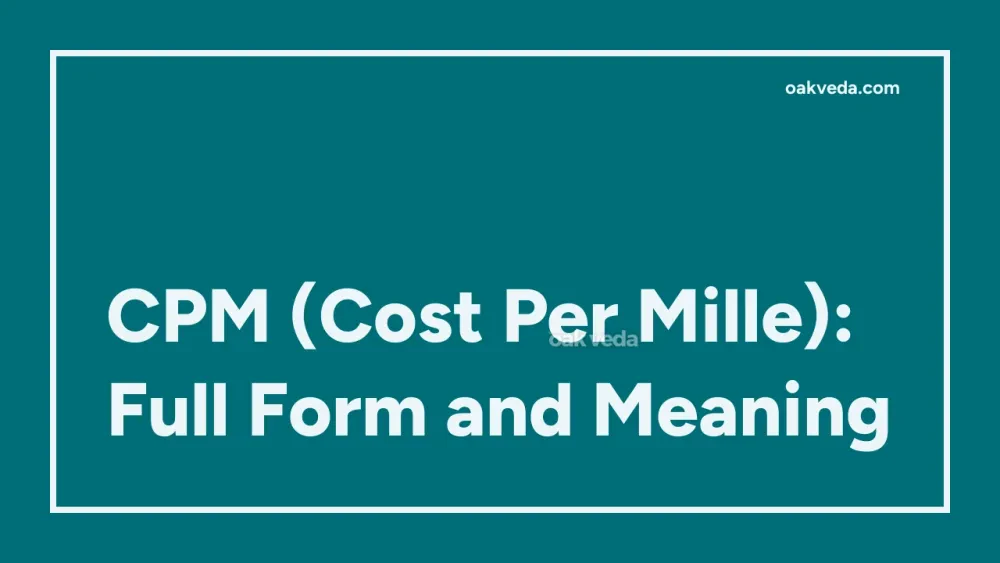
What is the Full Form of CPM?
The full form of CPM is Cost Per Mille. In the context of digital advertising, "mille" is derived from the Latin word for thousand. Therefore, CPM is often referred to as "Cost Per Thousand" in English-speaking countries.
What is Cost Per Mille (CPM)?
Cost Per Mille (CPM) is a fundamental pricing model used in digital advertising. It represents the cost an advertiser pays for every 1,000 ad impressions on a web page. An impression occurs each time an ad is displayed, regardless of whether it is clicked or not.
For example, if a website charges ₹150 CPM, an advertiser would pay ₹150 for every 1,000 times their ad is shown on that website. The formula to calculate CPM is:
CPM = (Total Cost / Number of Impressions) x 1000
Origin and Development of Cost Per Mille
The concept of CPM has its roots in traditional media advertising, particularly in print and television. As the internet evolved and digital advertising became prominent, CPM naturally transitioned into the online space. It has since become one of the most widely used pricing models in digital marketing.
How does Cost Per Mille work?
CPM works by charging advertisers based on the number of times their ad is displayed, rather than on the actions taken by viewers. Here's a simplified breakdown of the process:
- An advertiser creates an ad campaign and sets a budget.
- They choose websites or platforms to display their ads.
- The ad is shown to users browsing these platforms.
- The advertiser is charged for every 1,000 impressions their ad receives.
Types of CPM
While CPM itself is a specific metric, there are variations in how it can be applied:
- eCPM (Effective Cost Per Mille): This calculates the effective cost per thousand impressions across different ad units or campaigns.
- vCPM (Viewable Cost Per Mille): This only counts impressions where the ad was actually viewable by users.
- CPM Targeting: This involves setting different CPM rates for specific audience segments or demographics.
Functions of Cost Per Mille
CPM serves several crucial functions in digital advertising:
- Pricing Model: It provides a standardized way to price ad inventory.
- Performance Measurement: CPM helps in comparing the cost-effectiveness of different ad placements.
- Budget Planning: Advertisers can estimate the reach of their campaigns based on CPM rates.
- Revenue Projection: Publishers can forecast their ad revenue using CPM rates.
Applications of Cost Per Mille
CPM is widely used across various digital advertising channels:
- Display Advertising: Banner ads on websites often use CPM pricing.
- Social Media Advertising: Platforms like Facebook and Instagram offer CPM-based ad options.
- Video Advertising: Pre-roll and mid-roll video ads frequently use CPM models.
- Mobile Advertising: In-app ads and mobile web ads often employ CPM pricing.
Features of Cost Per Mille
Key features of the CPM model include:
- Predictability: Advertisers know exactly how many impressions they're paying for.
- Scalability: CPM can be applied to campaigns of any size.
- Flexibility: It can be used across various ad formats and platforms.
- Simplicity: The concept is easy to understand and implement.
Benefits of Cost Per Mille
CPM offers several advantages:
- Brand Awareness: It's excellent for campaigns focused on increasing visibility.
- Reach: CPM allows advertisers to expose their message to a large audience.
- Budgeting: It's easier to predict and control costs with CPM.
- Publisher Revenue: For high-traffic websites, CPM can be more lucrative than other models.
Limitations or Challenges of Cost Per Mille
Despite its benefits, CPM has some drawbacks:
- No Guarantee of Engagement: Impressions don't necessarily translate to clicks or conversions.
- Potential for Wasted Spend: Ads might be shown to uninterested users.
- Ad Fraud: CPM can be susceptible to fraudulent practices like bot traffic.
- Viewability Issues: Not all counted impressions may be actually viewed by users.
Future Developments in Cost Per Mille Technology
The future of CPM is likely to see several advancements:
- AI-Driven Optimization: Machine learning algorithms will help optimize CPM bidding strategies.
- Enhanced Viewability Metrics: More sophisticated tools will ensure ads are genuinely viewable.
- Cross-Device Tracking: Improved technology will allow better tracking of impressions across multiple devices.
- Integration with Other Metrics: CPM may be combined with engagement metrics for more comprehensive campaign evaluation.
FAQs on CPM Full Form
-
How is CPM different from CPC? While CPM charges per thousand impressions, Cost Per Click (CPC) charges only when an ad is clicked.
-
Is a high CPM good or bad? It depends on the campaign goals. A high CPM might be acceptable for premium, targeted audiences but could be costly for broad reach campaigns.
-
Can CPM be used for all types of digital ads? While CPM is widely applicable, it's most suitable for awareness-focused campaigns rather than direct response advertising.
-
How does CPM affect ad revenue for publishers? Higher CPM rates generally mean more revenue for publishers, but this needs to be balanced with maintaining user experience.
-
What's a good CPM rate? CPM rates vary widely depending on factors like industry, targeting, and ad placement. It's important to benchmark against industry standards and campaign goals.
Understanding the full form and implications of CPM is crucial for both advertisers and publishers in the digital marketing landscape. By grasping its nuances, marketers can make more informed decisions about their advertising strategies and budget allocations.
You may be interested in:
- RNA (Ribonucleic Acid): Full Form and Functions
- NASA (National Aeronautics and Space Administration)
- MC (Menstrual Cycle): Full Form and Comprehensive Guide
- BIS (Bureau of Indian Standards) Full Form
- TGT (Trained Graduate Teacher): Full Form and Guide
- EVM (Electronic Voting Machine): Full Form Explained

